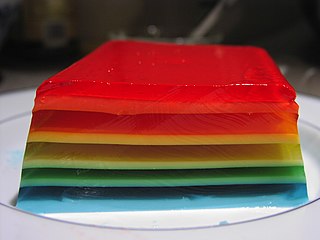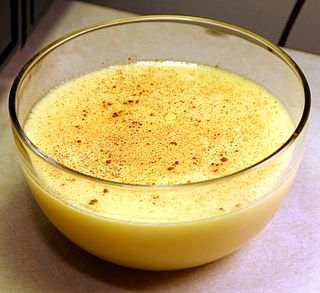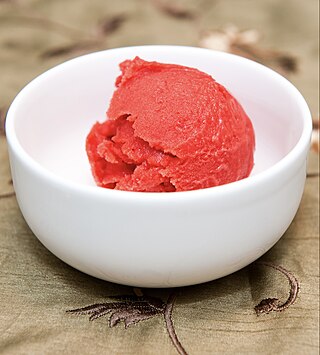
Gelatin desserts are desserts made with a sweetened and flavoured processed collagen product (gelatin). This kind of dessert was first recorded as jelly by Hannah Glasse in her 18th-century book The Art of Cookery, appearing in a layer of trifle. Jelly is also featured in the best selling cookbooks of English food writers Eliza Acton and Isabella Beeton in the 19th century.

Jell-O, stylised as JELL-O, is an American brand offering a variety of powdered gelatin dessert, pudding, and no-bake cream pie mixes. The original gelatin dessert is the signature of the brand. "Jell-O" is a registered trademark of Kraft Heinz, and is based in Chicago, Illinois.

A salad is a dish consisting of mixed ingredients, frequently vegetables. They are typically served chilled or at room temperature, though some can be served warm. Condiments and salad dressings, which exist in a variety of flavors, are often used to enhance a salad.

Custard is a variety of culinary preparations based on sweetened milk, cheese, or cream cooked with egg or egg yolk to thicken it, and sometimes also flour, corn starch, or gelatin. Depending on the recipe, custard may vary in consistency from a thin pouring sauce to the thick pastry cream used to fill éclairs. The most common custards are used in custard desserts or dessert sauces and typically include sugar and vanilla; however, savory custards are also found, e.g., in quiche.

Trifle is a layered dessert of English origin. The usual ingredients are a thin layer of sponge fingers or sponge cake soaked in sherry or another fortified wine, a fruit element, custard and whipped cream layered in that order in a glass dish. The contents of a trifle are highly variable and many varieties exist, some forgoing fruit entirely and instead using other ingredients, such as chocolate, coffee or vanilla. The fruit and sponge layers may be suspended in fruit-flavoured jelly, and these ingredients are usually arranged to produce three or four layers. The assembled dessert can be topped with whipped cream or, more traditionally, syllabub.

Pudding is a type of food. It can be either a dessert, served after the main meal, or a savoury dish, served as part of the main meal.

Cheesecake is a dessert made with a soft fresh cheese, eggs, and sugar. It may have a crust or base made from crushed cookies, graham crackers, pastry, or sometimes sponge cake. Cheesecake may be baked or unbaked, and is usually refrigerated.

Shortcake generally refers to a dessert with a crumbly scone-like texture. There are multiple variations of shortcake, most of which are served with fruit and cream. One of the most popular is strawberry shortcake, which is typically served with whipped cream. Other variations common in the UK are blackberry and clotted cream shortcake and lemon berry shortcake, which is served with lemon curd in place of cream.

Eton mess is a traditional English dessert consisting of a mixture of strawberries or other berries, meringue, and whipped cream. First mentioned in print in 1893, it is commonly believed to originate from Eton College and is served at the annual cricket match against the pupils of Harrow School. Eton mess is occasionally served at Harrow School, where it is referred to as Harrow mess.

Jello salad is an American salad made with flavored gelatin, fruit, and sometimes grated carrots or other vegetables. Other ingredients may include cottage cheese, cream cheese, marshmallows, nuts, or pretzels. Jello salads were popular in the 1960s and are now considered retro.

A fool is an English dessert. Traditionally, fruit fool is made by folding puréed stewed fruit into sweet custard. Modern fool recipes often skip the traditional custard and use whipped cream. Additionally, a flavouring agent such as rose water may be added.

The Redwall Cookbook is a cookbook based on food from the Redwall series. It contains recipes mentioned in the books, from Deeper'n'Ever Pie and Summer Strawberry Fizz to Abbey Trifle and Great Hall Gooseberry Fool.

Sorbet is a frozen dessert made using ice combined with fruit juice, fruit purée, or other ingredients, such as wine, liqueur, or honey. Generally, sorbets do not contain dairy products.

Watergate salad, also referred to as Pistachio Delight or Shut the Gate salad, is a side dish salad or dessert salad made from pistachio pudding, canned pineapple, whipped topping, crushed pecans, and marshmallows. It is very quick and simple to prepare: the ingredients are combined and then often chilled. It is a popular dish in the Upper Midwest and other areas of the U.S. where potlucks are popular.

A banana split is an American ice cream-based dessert consisting of a peeled banana cut in half lengthwise, and served with ice-cream and sauce between the two pieces. There are many variations, but the classic banana split is made with three scoops of ice cream. A sauce or sauces are drizzled onto the ice cream, which is topped with whipped cream and maraschino cherries. Crushed nuts are optional.

Rødgrød, rote Grütze, or rode Grütt, meaning "red groats", is a sweet fruit dish from Denmark and Northern Germany. The name of the dish in Danish features many of the elements that make Danish pronunciation difficult for non-native speakers, so, literally "red porridge with cream", has been a commonly used shibboleth since the early 1900s.

Sponge cake is a light cake made with eggs, flour and sugar, sometimes leavened with baking powder. Some sponge cakes do not contain egg yolks, like angel food cake, but most of them do. Sponge cakes, leavened with beaten eggs, originated during the Renaissance, possibly in Spain. The sponge cake is thought to be one of the first non-yeasted cakes, and the earliest attested sponge cake recipe in English is found in a book by the English poet Gervase Markham, The English Huswife, Containing the Inward and Outward Virtues Which Ought to Be in a Complete Woman (1615). Still, the cake was much more like a cracker: thin and crispy. Sponge cakes became the cake recognised today when bakers started using beaten eggs as a rising agent in the mid-18th century. The Victorian creation of baking powder by English food manufacturer Alfred Bird in 1843 allowed the addition of butter to the traditional sponge recipe, resulting in the creation of the Victoria sponge. Cakes are available in many flavours and have many recipes as well. Sponge cakes have become snack cakes via the Twinkie.
Pie in American cuisine has roots in English cuisine and has evolved over centuries to adapt to American cultural tastes and ingredients. The creation of flaky pie crust shortened with lard is credited to American innovation.
Watergate cake is a pistachio cake popular in the U.S. which shares its name with the Watergate scandal of the 1970s, although the name's origin is not clear. The cake pre-dates Watergate salad, a dessert made with similar ingredients including pistachio pudding.


















